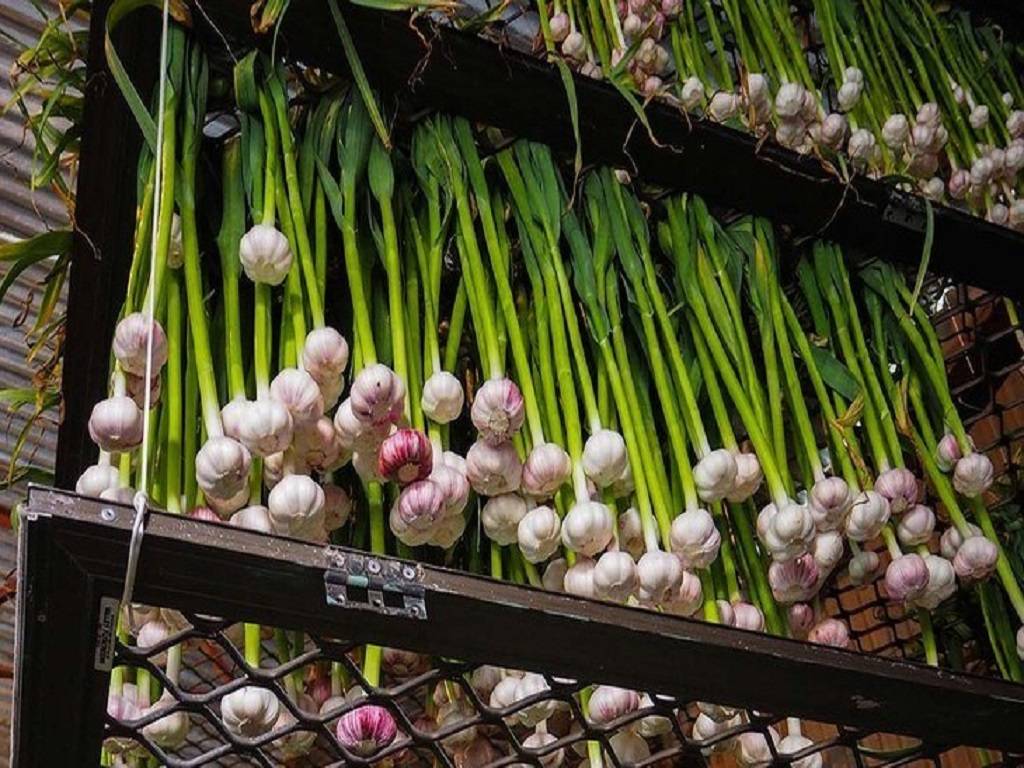
Garlic is an Allium crop that is high in vitamin B6, as well as many other vitamins and minerals such as manganese, vitamin C, selenium, and allicin (an anti-oxidant). It can be produced hydroponically with the use of artificial lighting and a substrate.
Garlic has a powerful stench, not just the bulbs, but the entire plant. Garlic is an excellent blood cleanser since it aids in the removal of toxins from the body. Garlic is in high demand throughout the year and, as a result, is a somewhat expensive vegetable. Because of its unique requirements, hydroponic garlic is a bit more difficult to cultivate.
Benefits of Cultivating Garlic Hydroponically
The benefits of hydroponic controlled environment agriculture include high plant density and maximum plant production. Hydroponics makes better use of water and nutrients while taking up less space on the farm. The advantage of hydroponics over field-grown vegetables is that the plant is isolated from the soil, which frequently includes pests, diseases, salinity, and drainage issues.
-
Gardening in hydroponics may be packed and kept alive and fresh for extended periods.
-
Hydroponics does not use any sort of solid medium at all. And complete control of the plant's root system, as well as maintaining constant eye contact.
-
There's no need to be concerned about over-watering or under-watering in a hydroponics system.
-
Hydroponic plants may thrive in any location and at any time.
Requirements for Growing Garlic Hydroponically
Light:
Allow plenty of light, at least 6 to 8 hours every day, but up to 10 or 12 hours is preferable. All plants require darkness, so don't keep the light on all the time.
Temperature:
Garlic plants are affected by temperature in two different ways. High temperatures hasten the development of the garlic plant, increasing the plant's requirement for water. Extreme temps also cause the Garlic plant to use more water to cool itself via evaporation. Garlic is quite hardy once planted, and temperature as low as 30°F for short periods and up to 85°F is fine.
Air:
Wind or air movement has a significant impact on the water usage of the plant, especially when accompanied by a high temperature, similar to how clothes dry significantly faster on a clothesline on a windy day.
Nutrient Requirements for Hydroponic Garlic farming:
The nutrient solution has a significant role in the success or failure of hydroponics. Most fertilizers sold in local nurseries do not include all of the 13 elements required for plant growth since the growing medium contains several of them. Because hydroponic plants acquire nutrients from a different source, it is critical to utilize a nutrient developed for hydroponic systems. Hydroponic fertilizers are available from a variety of mail order firms as well as a few specialist garden retailers.
It is critical to adhere to the dilution rate specified on the label and to test the solution to ensure that the pH of the Garlic is between 6 and 6.5. Two components of nutrition must be considered: nutrient availability from the nutrient delivery system and plant nutrient response.
Garlic thrives in hydroponics with a pH of at least 6.0 and up to 6.5. To ensure that your plants receive the right amounts of macro and micronutrients, you must constantly follow the requirements of the nutrient line you're using.
What are the conditions for Growing Garlic Hydroponically?
-
Choose the most flavorful garlic cloves. You may get garlic at a local market or a Garlic nursery. Plant the large garlic cloves leaving the papery wrapping.
-
After that, put your garlic in perlite vermiculite mix or even coco coir, with the point facing upwards. The plant roots, on the other hand, will sprout from the other end.
-
Place them slightly beneath the surface of the earth, making sure the tip is not exposed. Carefully water them.
-
Garlic should be planted in temperatures ranging from 40 to 60 ℉.
What is the process of growing garlic hydroponically?
Garlic grows to be quite a tall plant. You'll need moveable to grow lights for different phases of plant development. Because of its height, it's also recommended to utilize a reflective material like aluminum. Garlic may be grown from seed, however, "cloves" are preferable. Each clove, which is a portion of the whole bulb, will generate a new bulb. If you're starting with store-bought garlic, you won't have much of a say in the plant variety you cultivate.
Garlic may be grown from seeds or purchased as cloves. Experts agree that cloves are the best place to start when growing plants indoors or in hydroponic systems. Perlite or a mixture of perlite and vermiculture can be used as a growth medium in hydroponics. Coco coir can also be used, however, it will float away, resulting in a lack of stability for the future plant.
Keep in mind that you'll need to adjust the water once the plant roots develop. Due to the sensitivity of this plant, water content might promote immediate rooting. The Garlic plants will emerge after 45 to 60 days. Temperatures between 35°F and 50°F are ideal. Plants should be spaced around 3 1/2 to 4 inches apart.
What are Pests and Diseases associated with Garlic Farming?
Garlic is a natural pest repellant; therefore it doesn't have many difficulties with pests. Fungal diseases, such as white Rot, are the most frequent diseases that afflict garlic. Garlic will be attacked by certain onion pests.
Is Hydroponic Garlic Farming Profitable?
Yes, Growing garlic in a hydroponic system is profitable and more productive than that other farming method of growing garlic. A hydroponic system can boost the yield by 3-10 times more than traditional produce.











